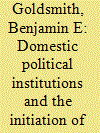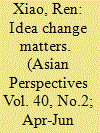| Srl | Item |
| 1 |
ID:
131387


|
|
|
|
|
| Publication |
2014.
|
| Summary/Abstract |
There is doubt about whether the 'democratic peace' proposition applies in Asia. I theoretically deconstruct regime type into institutional components including political competition, constraint on the executive, and mass participation, and ask whether taking these as distinct causal factors gives more empirical purchase on the relationship of domestic political institutions to states' external conflict behavior. I find that higher levels of political competition are associated with a lower likelihood of conflict initiation, but only when the potential target is relatively democratic. Thus, my directed-dyad analysis is consistent with a democratic peace effect in East Asia. It is also suggestive regarding the observed 'East Asian peace' that has existed since 1979, because levels of political competition have risen considerably in the region, beginning in the late 1970s.
|
|
|
|
|
|
|
|
|
|
|
|
|
|
|
|
| 2 |
ID:
145406


|
|
|
|
|
| Summary/Abstract |
In this article I examine the changes in China's foreign policy thinking and how they have influenced China's international behavior. I reveal how the leadership's beliefs guided and drove the Chinese state's behavior. When leaders believed that the world was in a “war and revolution” age, China was inclined to overlook the actual international order and institutions and backed revolutionary movements or armed struggles in other countries. The cognitive shift to “peace and development” in the 1980s, which was consolidated in the 1990s through two major debates, was fundamental in terms of strategically reshaping China's behavior, turning it from a revolutionary state into a quasi–status quo state. Besides embracing international institutions, China has also joined neighboring countries in creating new regional institutions and norms in East Asia. I argue that ideas, and not only perceptions, guide China's policymaking and international behavior.
|
|
|
|
|
|
|
|
|
|
|
|
|
|
|
|